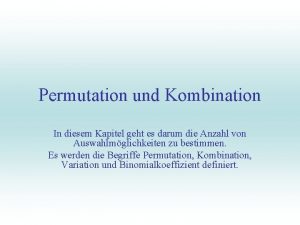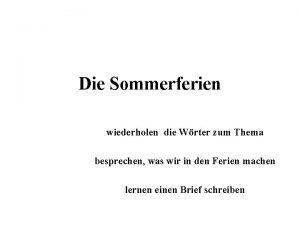FREE FRANK and FREE LUCY Mc WORTER Founders






- Slides: 6

FREE FRANK and FREE LUCY Mc. WORTER Founders of New Philadelphia Free Frank Mc. Worter was born in slavery in South Carolina in 1777. His owner took him to Kentucky, where he met his wife Lucy, enslaved on a neighboring farm. With the permission of his owner, Frank worked for wages. He eventually established saltpeter works in Kentucky, bought land purchased freedom for his wife, himself and his eldest son, Young Frank and Lucy had seven children, four in slavery and three in freedom. Juda, Sarah and Solomon remained in bondage in Kentucky when Free Frank and Free Lucy came to Illinois in 1830. The first settlers in Hadley Township, they established a farm and freed Solomon. In 1836, they laid out the town of New Philadelphia south of their farm. They hoped to sell enough lots to secure the freedom of their two eldest daughters and their grandchildren. Frank Mc. Worter lived to see all of his children free and living in the New Philadelphia community by 1850. However, several grandchildren remained in bondage and work continued to free them after Frank’s death in 1854. Lucy Mc. Worter lived to be nearly 100 years old, dying on her farm north of town in 1870. Bust of Free Frank Mc. Worter sculpted by Shirley Mc. Worter Moss. Photograph by Doug Carr. Photograph of Free Lucy Mc. Worter courtesy of H. Conle White, Charles and Dee Porter, Karen Wall and the Clark Family descendants.

New Philadelphia: The Town, The Community The New Philadelphia community was racially and ethnically integrated. Americans of both African and European descent came from Kentucky, Virginia, Missouri, Pennsylvania, Ohio, Delaware, New York, and the New England states. N Reuben and Clarissa Shipman of Connecticut Farm of Free Frank Mc. Worter Kezia Clark, former slave from Kentucky Anson Gray of Ohio New Philadelphia John and Sophia Kirtright of Ohio Thomas and Sophia Thomas, former slaves from Missouri James Robertson, Scottish Immigrant Detail of 1872 Atlas Map of Pike County, Illinois, showing location of New Philadelphia and surrounding farmland.

New Philadelphia and the Underground Railroad Frank Mc. Worter and his family worked all of their lives to gain freedom and abolish slavery. Mc. Worter purchased freedom for his wife in 1817 and himself in 1819. He traded his saltpeter operation in 1829 so that son Young Frank could return a freed man from Canada, where he sought refuge in 1826. Lot sales in New Philadelphia helped fund freedom for at least ten additional family members, but required return trips to Kentucky and the risk of capture by slave catchers, who were notorious for returning free people to bondage. Simeon Clark came to New Philadelphia with his family in the early 1840 s. Eventually he left New Philadelphia to live in Quincy, where he associated with well-known abolitionists before the Civil War. He later declared that for 25 years, he had, “time and again, assisted his flying brothers from the pursuit of the negro-hunter and his bloodhounds. " Despite its proximity to the slave states of Missouri and Kentucky, New Philadelphia became a place of refuge and source of assistance for freedom seekers. Family oral tradition recalls that Mc. Worter family members not only aided freedom seekers, but sometimes accompanied them to Canada. Photograph of Simeon Clark courtesy of the Clark Family. Simeon Clark Local resident, Clarissa Shipman, wrote in a letter that neighbors captured and were paid $1200 for the return of four freedom seekers who may have been en route to New Philadelphia: "There seems reason to believe that the fugitives are enticed to flee here. They came as far as Barry, as though they were among friends. There they were set upon and returned. I think we have fallen on evil times. "

New Philadelphia in the Civil War Era Danger in Pike County A racially integrated community that served as a haven former slaves and freedom seekers, New Philadelphia found itself surrounded by danger on all sides during the Civil War. Pike County was bitterly divided between equally violent Union and Confederate sympathizers. Several murders occurred in the county, including early Hadley Township settler P. C. Staats, an ardent Southern sympathizer, who was shot in the back by two Union soldiers. MURDER OF PETER C. STAATS On last Saturday afternoon, Peter C. Staats, of Hadley township, one of the old settlers of Pike county was found dead in the road leading from new Salem to New Maysville, a short distance from Peter Hooper’s residence. New Philadelphia Soldiers Young men from New Philadelphia and Hadley Township served in the 99 th Illinois Infantry, the th th 29 U. S. Colored Infantry and the 38 U. S. Colored Infantry. Although the armed forces were officially segregated, at least one young mulatto man from New Philadelphia served with his white neighbors in the 99 th Illinois Infantry. Brothers Thomas and Simeon Clark and their nephew, Squire Mc. Worter (grandson of Free Frank), served in the 38 th U. S. Colored Troops. Thomas Clark Post-War Era The end of the war brought changes to the New Philadelphia community. At least two war widows lived in the town. Free Frank’s daughter-in-law, Louisa Mc. Worter, adopted a war orphan and brought him to live here. Several young men recently freed from slavery became farm laborers in the township. Of these, William Butler and brothers George and Martin Kimbro would settle here permanently. Pike County Democrat, March 3, 1864 Photo courtesy of the Clark Family.

How Many People Lived in New Philadelphia? As an unincorporated town, New Philadelphia residents were counted as part of Hadley Township by the U. S. Census takers. By comparing the census schedules to property tax records and family histories, we are able to estimate that the number of families living within the town limits ranged from 5 in 1845 to 17 in 1865. At its peak population in the 1850 s and 1860 s, about 70 people lived in the town. Monroe, Alexander and Thomas Clark Mc. Worter Family Reunion, ca. 1920 Children of Hiley Mc. Worter and Alexander Clark, ca. 1872 Kellum Family, ca. 1900 Photographs courtesy of Clark, Mc. Worter and Kellum Families The New Philadelphia community consisted of more than the people living within the town limits. The surrounding farm families used the services of the blacksmith, shoemaker, wagon maker, and carpenter. They bought supplies, attended school, and participated in religious services here. Because the community was small, historians and archaeologists are able to study its 100 year history in close detail.

New Philadelphia Hadley Township, Pike County, Illinois N You are here D. A. Kittle store (1850) Blacksmiths Spaulding Burdick, shoemaker (1846 -1866) Rev. C. S. Luce home and U. S. Post Office (1850) School house (1848 -1874) George & Martin Kimbro (1885 -1907) Surveyed and filed on September 16, 1836, New Philadelphia was the first town in the United States founded by an African American. National Register of Historic Places Louisa Clark Mc. Worter house (1848 -1883) Burdick House (present) National Historic Landmark National Underground Railroad Network to Freedom Map of “Philadelphia“ from the 1872 Atlas Map of Pike County, Illinois.











